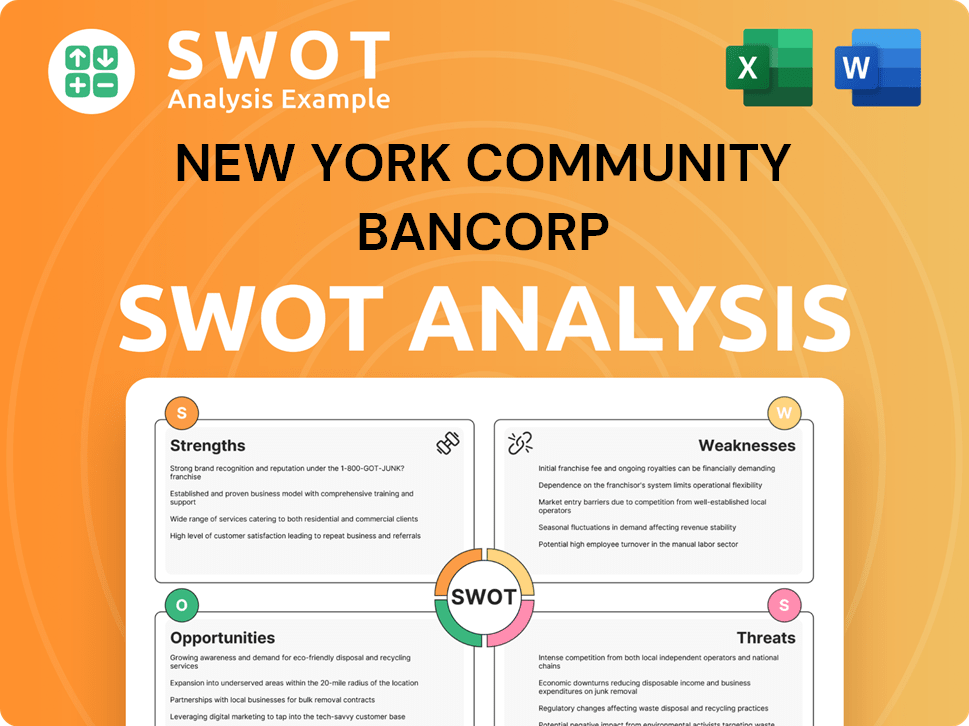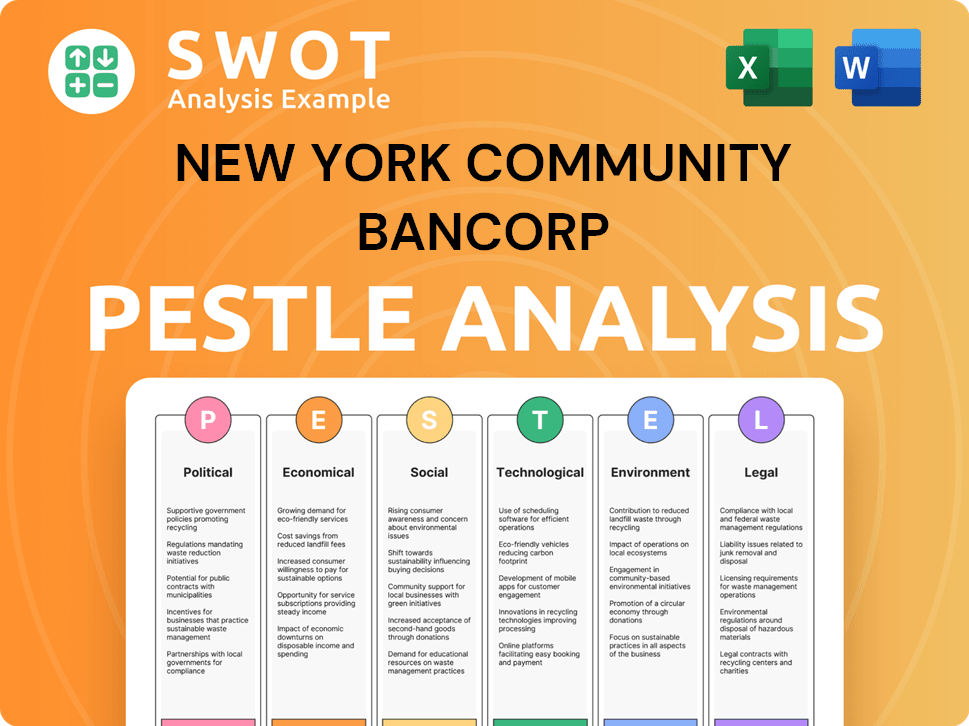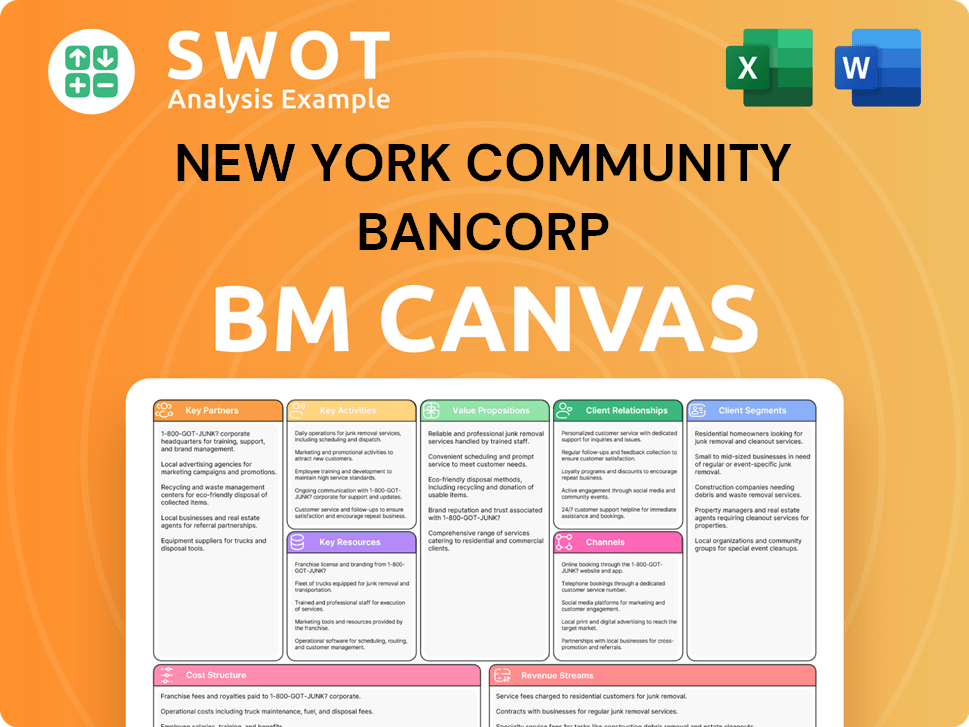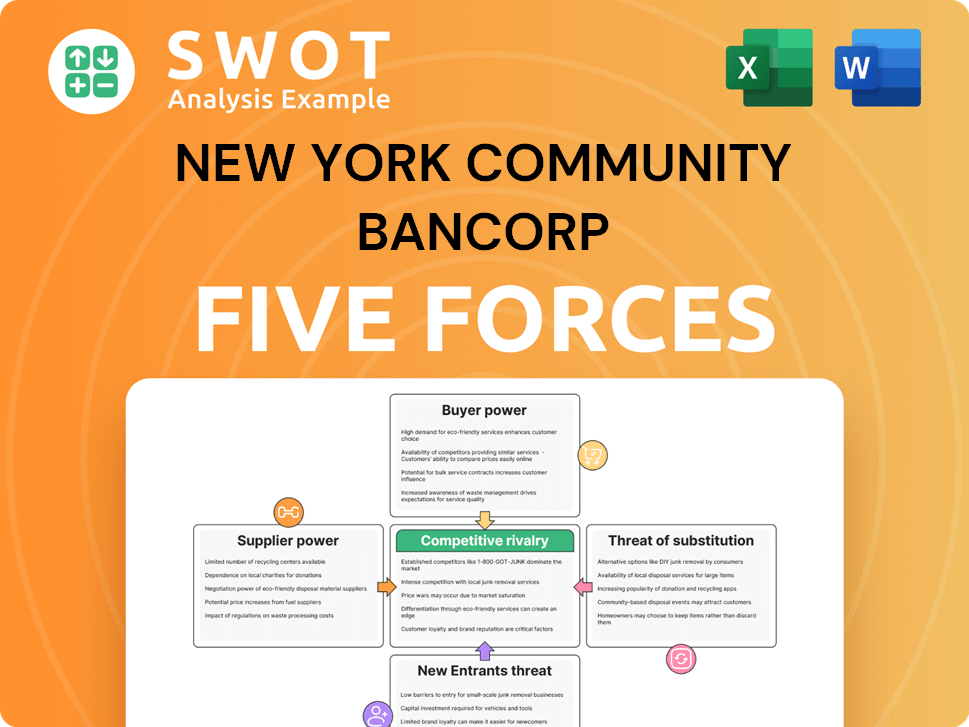New York Community Bancorp Bundle
Can New York Community Bancorp Navigate the Changing Banking Landscape?
New York Community Bancorp (NYCB) is at a pivotal juncture, marked by strategic shifts and a drive for sustained growth within the evolving banking industry. From its roots as a community-focused savings bank, NYCB has expanded significantly, now operating over 400 branches across several states. This expansion, along with recent acquisitions, has positioned NYCB for both opportunities and challenges in the competitive financial market.

Understanding the New York Community Bancorp SWOT Analysis is crucial to grasp the company's current position and future trajectory. NYCB's growth strategy focuses on expansion, innovation, and financial performance, all while addressing regulatory scrutiny. This analysis will delve into NYCB's strategic plan, examining its future prospects and long-term investment strategy within the context of the banking industry's dynamic environment, providing insights into the future of NYCB stock.
How Is New York Community Bancorp Expanding Its Reach?
The strategic direction of New York Community Bancorp (NYCB) is evolving, with a focus on becoming a more diversified regional bank. This transformation is underscored by the rebranding to Flagstar Financial, Inc., effective October 25, 2024, and the corresponding stock symbol change to FLG on October 28, 2024. This shift, along with the earlier rebranding of its Flagstar Bank branches, reflects a commitment to a broader market presence and a diversified financial portfolio.
A key element of NYCB's growth strategy involves reducing its reliance on commercial real estate (CRE) loans, particularly multifamily loans. This strategic pivot aims to balance the bank's risk profile and foster more sustainable growth. The bank is actively de-risking its portfolio to achieve these goals.
The company anticipates deposit and loan growth starting in late 2025, indicating the expected positive impact of these strategic initiatives.
NYCB is expanding its commercial and industrial (C&I) lending operations. The objective is to increase C&I loans from approximately $16 billion to $30 billion over the next three to five years. This expansion is a central part of the company's strategy to diversify its revenue streams and reduce its dependence on specific loan types.
The bank is actively working to grow its retail and private banking deposits. In the third quarter of 2024, retail deposits increased by $2.5 billion (8%), and private banking deposits rose by $1.8 billion (11%). This focus on deposit growth is vital for funding loan expansion and improving overall financial stability.
NYCB is exiting non-core business segments, including the planned sale of its residential mortgage servicing business to Mr. Cooper Group. This strategic move allows the bank to focus its resources on core banking activities and improve operational efficiency. These actions are designed to streamline operations and concentrate on areas with higher growth potential.
In the second quarter of 2024, multifamily loans decreased by 2% or $848 million. CEO Joseph Otting is committed to reducing the bank's CRE exposure. Commercial real estate exposure declined by 3% in Q3 2024. These actions are designed to streamline operations and concentrate on areas with higher growth potential.
NYCB's expansion initiatives are designed to enhance its financial performance and market position. The strategic shift towards a diversified regional bank model, coupled with a focus on C&I lending and deposit growth, aims to create long-term value. These efforts are supported by strategic exits from non-core business segments to streamline operations and improve efficiency.
- Rebranding to Flagstar Financial, Inc.
- Reducing reliance on CRE loans.
- Expanding C&I lending.
- Increasing retail and private banking deposits.
- Exiting non-core business segments.
New York Community Bancorp SWOT Analysis
- Complete SWOT Breakdown
- Fully Customizable
- Editable in Excel & Word
- Professional Formatting
- Investor-Ready Format

How Does New York Community Bancorp Invest in Innovation?
As Flagstar Financial, formerly known as New York Community Bancorp (NYCB), navigates its transformation, its innovation and technology strategy is becoming increasingly important. The company is focused on adapting to the evolving needs of its customers and the competitive landscape of the banking industry. This involves a strategic shift towards digital transformation and operational efficiency to support its growth strategy.
Flagstar Financial's rebranding and branch redesigns emphasize its commitment to a customer-centric approach. This suggests investments in digital platforms and technological infrastructure. The company's efforts to improve risk management and regulatory compliance indicate further technological enhancements to improve oversight and monitoring.
The strategic direction of NYCB, now Flagstar Financial, involves several key areas. These include a focus on digital transformation, operational efficiency, and customer-centricity. These areas are crucial for the company's growth strategy and future prospects in the banking industry.
Flagstar Financial is investing in digital platforms to enhance customer experience. This includes a unified visual identity across digital and traditional platforms. The goal is to provide seamless services and improve customer engagement.
The company aims to improve operational efficiency through technological solutions and automation. Expense reduction initiatives are expected to save $200 million annually. This focus helps streamline operations and reduce costs.
Flagstar Financial is investing in systems to improve risk management and regulatory compliance. This includes enhancing oversight and monitoring capabilities. These efforts are essential for maintaining financial stability and regulatory adherence.
The company's focus on attracting new retail and private banking deposits reflects a customer-centric approach. This requires competitive digital banking platforms and efficient technological infrastructure. The goal is to meet customer needs and improve service delivery.
The complete redesign of Flagstar's more than 400 branches underscores its commitment to digital transformation. This initiative aims to create modern, customer-friendly spaces. The redesign is part of a broader effort to enhance the overall customer experience.
The strategic shift towards a diversified regional bank necessitates advanced technological capabilities. This includes supporting growth, attracting new customers, and maintaining a competitive edge. These technological advancements are vital for long-term success.
The future prospects of Owners & Shareholders of New York Community Bancorp depend on these technological and innovative strategies. By focusing on digital transformation, operational efficiency, and customer-centric approaches, Flagstar Financial aims to secure its place in the competitive banking industry. The successful implementation of these strategies is crucial for driving financial performance and achieving long-term growth. While specific details on R&D investments are not extensively detailed in recent reports, the strategic direction suggests a commitment to leveraging technology for future success.
New York Community Bancorp PESTLE Analysis
- Covers All 6 PESTLE Categories
- No Research Needed – Save Hours of Work
- Built by Experts, Trusted by Consultants
- Instant Download, Ready to Use
- 100% Editable, Fully Customizable

What Is New York Community Bancorp’s Growth Forecast?
The financial outlook for New York Community Bancorp (NYCB) has been adjusted, reflecting strategic shifts. The company's performance in early 2024 showed significant losses, influencing the projections for the remainder of the year and into 2025. This financial trajectory is crucial for understanding the New York Community Bancorp's Growth Strategy and its Future Prospects.
NYCB reported a net loss of $327 million in Q1 2024, with a net loss attributable to common shareholders of $335 million. The first six months of 2024 saw a net loss attributable to common stockholders of $668 million. These figures highlight the challenges the company faces as it navigates its current strategic transition. The Banking Industry is closely watching these developments.
In Q3 2024, NYCB reported a net loss of $280 million, with a net loss attributable to common stockholders of $289 million. Analysts have adjusted their expectations, forecasting a full-year 2024 revenue of $2.22 billion and an earnings per share (EPS) of -$2.96. For 2025, revenue is estimated at $2.18 billion, with earnings expected at $0.06 per share. These revisions are pivotal for assessing the Financial Performance of NYCB.
In March 2024, NYCB secured over $1 billion in capital from private equity investors. This capital injection improved the company's consolidated leverage ratio and total risk-based capital ratio. This is a key element in the New York Community Bancorp's strategic plan.
NYCB aims to achieve a return on average earnings assets of 1% and a return on average tangible common equity of 11% to 12% by the end of 2026. The company is targeting profitability for 2026, with expectations of 75 cents to 80 cents per share. These targets are crucial for the NYCB stock forecast.
NYCB anticipates generating approximately $1.4 billion of pretax, pre-provision operating income in 2024 and 2025 to absorb loan losses. This financial buffer is critical for navigating the current economic environment. This is a key part of the NYCB market analysis.
The company is targeting a common equity tier 1 capital in the range of 11% to 12%. This focus on capital strength is a key component of the NYCB future investment opportunities. Also check out the Marketing Strategy of New York Community Bancorp.
New York Community Bancorp Business Model Canvas
- Complete 9-Block Business Model Canvas
- Effortlessly Communicate Your Business Strategy
- Investor-Ready BMC Format
- 100% Editable and Customizable
- Clear and Structured Layout

What Risks Could Slow New York Community Bancorp’s Growth?
The path forward for New York Community Bancorp (NYCB) is fraught with challenges. Its strategic plan to achieve growth is complicated by significant risks, primarily stemming from its concentrated exposure to commercial real estate (CRE) loans. These risks could significantly affect the company's financial performance and its ability to execute its growth strategy.
NYCB's future prospects are also shaped by regulatory changes. The company's status as a Category IV bank necessitates compliance with more stringent capital and liquidity requirements. The need to diversify its loan portfolio and improve risk management adds further complexity to its strategic initiatives.
The banking industry faces constant evolution, and NYCB's ability to navigate these obstacles will determine its long-term success. Understanding these risks is crucial for investors and stakeholders assessing NYCB's potential.
NYCB faces significant risks due to its concentration in CRE loans, particularly those backed by rent-regulated multifamily buildings in New York City. High interest rates, inflation, and declining property values put pressure on borrowers. This can lead to increased loan defaults and reduced profitability.
As a Category IV bank, NYCB is subject to stricter regulatory requirements. This includes annual capital plan submissions to the Federal Reserve and supervisory stress tests. 'Material weaknesses' in internal controls related to loan review have led to increased scrutiny.
NYCB's loan loss provisions increased significantly in 2024, reflecting the risks in its loan portfolio. Anticipated provisions for the full year are projected to be between $1.1 billion and $1.2 billion. This increase impacts the company's financial performance.
The banking industry is highly competitive. NYCB faces challenges in diversifying its loan portfolio away from its traditional CRE focus. This transition requires time and significant effort to grow commercial and industrial lending, which is a key element of its growth strategy.
The company's turnaround is expected to be a long-term effort. Growth is projected to pick up in 2027. This extended timeline means that NYCB's strategic initiatives will require sustained effort and patience from investors.
A recent capital raise of over $1 billion aims to bolster capital and instill investor confidence. This capital is crucial for absorbing potential loan losses. Improving risk management and regulatory compliance are key priorities for management.
By Q3 2024, net charge-offs for multifamily and office loans totaled $188 million and $388 million respectively. These figures highlight the financial strain on the company. The increased loan loss provisions also affect overall profitability and financial stability, making it crucial for NYCB to manage these risks effectively. Investors should monitor these metrics closely to assess the company's financial health.
The need to diversify its loan portfolio away from its traditional CRE focus is a significant strategic challenge. This transition takes time and significant effort. Successfully navigating these challenges is critical for the company's growth strategy. For more insights, consider reading about Mission, Vision & Core Values of New York Community Bancorp to understand the company's long-term goals.
New York Community Bancorp Porter's Five Forces Analysis
- Covers All 5 Competitive Forces in Detail
- Structured for Consultants, Students, and Founders
- 100% Editable in Microsoft Word & Excel
- Instant Digital Download – Use Immediately
- Compatible with Mac & PC – Fully Unlocked

Related Blogs
- What are Mission Vision & Core Values of New York Community Bancorp Company?
- What is Competitive Landscape of New York Community Bancorp Company?
- How Does New York Community Bancorp Company Work?
- What is Sales and Marketing Strategy of New York Community Bancorp Company?
- What is Brief History of New York Community Bancorp Company?
- Who Owns New York Community Bancorp Company?
- What is Customer Demographics and Target Market of New York Community Bancorp Company?
Disclaimer
All information, articles, and product details provided on this website are for general informational and educational purposes only. We do not claim any ownership over, nor do we intend to infringe upon, any trademarks, copyrights, logos, brand names, or other intellectual property mentioned or depicted on this site. Such intellectual property remains the property of its respective owners, and any references here are made solely for identification or informational purposes, without implying any affiliation, endorsement, or partnership.
We make no representations or warranties, express or implied, regarding the accuracy, completeness, or suitability of any content or products presented. Nothing on this website should be construed as legal, tax, investment, financial, medical, or other professional advice. In addition, no part of this site—including articles or product references—constitutes a solicitation, recommendation, endorsement, advertisement, or offer to buy or sell any securities, franchises, or other financial instruments, particularly in jurisdictions where such activity would be unlawful.
All content is of a general nature and may not address the specific circumstances of any individual or entity. It is not a substitute for professional advice or services. Any actions you take based on the information provided here are strictly at your own risk. You accept full responsibility for any decisions or outcomes arising from your use of this website and agree to release us from any liability in connection with your use of, or reliance upon, the content or products found herein.